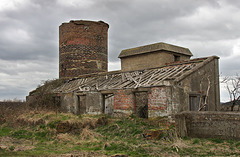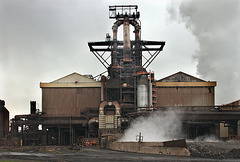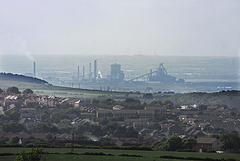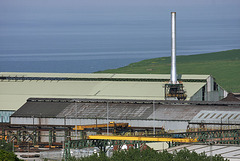tarboat's photos with the keyword: cleveland
Redcar furnace at work
| 04 Jun 2022 |
|
|
Opening in 1979, the Redcar blast furnace was the largest in the UK and the second largest in Europe. It was capable of producing 10,000 tonnes of iron per day. It had a chequered career after this photo was taken in 2010 shortly before it was shut down. Revived in 2012 it was in blast for just three years before the final shutdown and closure of the steelworks.
Boulby Mine
| 15 Sep 2020 |
|
|
Boulby Potash Mine is operated by Cleveland Potash Ltd, a subsidiary of Israel Chemicals Ltd. There are two 5.5m diameter shafts to a depth of around 1150m. The potash averages 7m in thickness but ranges from nil to over 20m. Beneath the potash there are rock salt beds of about 40m and the main roadways for the mine are driven in pure rock salt 8-10m below the potash.
Skinningrove steelworks
| 27 Dec 2014 |
|
|
|
The last blast furnace at Skinningrove ironworks was shut down in 1972 but the rolling mill continues in production. Tata Steel produces over 240,000 tons a year of finished steel in special profiles from the plant here.
Wilton Works
| 08 Mar 2011 |
|
Part of the extensive chemical complex at Wilton viewed from the railway bridge at Coatham.
Skelton Park
| 15 Jan 2011 |
|
The Skelton Park ironstone mine was sunk by Bell Brothers in 1872 with two shafts of 378 ft (upcast) and 384 ft (downcast), both 14ft in diameter. Bell Brothers were taken over by Dorman Long and Co Ltd in 1923 and that company operated the mine until closure in 1938. It is reckoned that the mine produced in excess of 18.5 million tons of ironstone.
To the left is the top of the upcast shaft and fan house with the roofless main winding enginehouse centre and power house on the right.
Decoy
| 26 Sep 2010 |
|
At the side of the road from the Middlesbrough Transporter Bridge across Seal Sands towards Hartlepool stands this pair of structures. They comprise (left) the generator/command bunker and (right) shelter of a WWII decoy site. Both buildings were originally covered with earth. The command bunker was connected to a Starfish Decoy some distance away across the marshes. This would have been lit to give the impression of burning buildings to lure bombers away from their intended targets along the Tees.
The background features the Huntsman Tioxide, Greatham Works.
Skelton Park Ironstone Mine
| 09 Oct 2010 |
|
The Skelton Park mine was sunk by Bell Brothers in 1872 with two shafts of 378 ft (upcast) and 384 ft (downcast), both 14ft in diameter. Bell Brothers were taken over by Dorman Long and Co Ltd in 1923 and that company operated the mine until closure in 1938. It is reckoned that the mine produced in excess of 18.5 million tons of ironstone.
This is the top of the upcast shaft and fan house although initially ventilation was by a furnace at the bottom of the shaft. In November 1882 a 12ft 1½ins diameter Schiele fan was installed in a concrete house with a steam engine to drive it. The shaft top brickwork was raised by 8ft to allow cross girders to be installed to carry a pulley wheel for winding in the shaft. The concrete structure on top of the building is the evasee for the fan.
Pillbox at Redcar furnace
| 08 Feb 2010 |
|
Defending the coast and the steelworks. Pillbox on the dunes/slag outside the Redcar steelworks. The brick facing was, I believe, initially used as a form of shuttering for pouring the concrete. It was then left in situ as extra protection.
Furnace and huts
| 26 Jan 2010 |
|
I made a sad trip to Teesside to say goodbye to the blast furnace and steel plant that are due to be mothballed (closed) by Corus by the end of January.
The Redcar furnace and associated coke and chemical plant are seen here over the conglomeration comprising the encampment of the South Gare Fishermen's Huts Association.
Redcar gasholders
| 26 Jan 2010 |
|
Gasholders adjacent to the coking plant and blast furnace at Redcar.
Renown gives scale whilst making his own shot.
Redcar furnace
| 28 Jan 2010 |
|
Not long left for the Redcar furnace that produces 10,000 tonnes of iron a day.
Filling the torpedoes
| 28 Jan 2010 |
|
Tapping molten iron into the torpedo wagons beneath the blast furnace for transfer to the steel plant at Redcar.
Redcar Panorama
British Oxygen Co, Lackenby
Boulby Potash Mine
| 30 Dec 2008 |
|
Boulby Potash Mine is operated by Cleveland Potash Ltd, a subsidiary of Israel Chemicals Ltd. There are two 5.5m diameter shafts to a depth of around 1150m. The potash averages 7m in thickness but ranges from nil to over 20m. Beneath the potash there are rock salt beds of about 40m and the main roadways for the mine are driven in pure rock salt 8-10m below the potash.
Boulby Potash Mine
| 27 Aug 2008 |
|
Boulby Potash Mine is operated by Cleveland Potash Ltd, a subsidiary of Israel Chemicals Ltd. There are two 5.5m diameter shafts to a depth of around 1150m. The potash averages 7m in thickness but ranges from nil to over 20m. Beneath the potash there are rock salt beds of about 40m and the main roadways for the mine are driven in pure rock salt 8-10m below the potash.
Redcar
| 31 Aug 2008 |
|
On my summer holiday I spent an afternoon exploring industrial remains in North Yorkshire. My peregrinations led me to the spoil heap of the Kilton ironstone mine from the top of which the views were extensive and fascinating. To the north could be seen the last remaining blast furnace in the area at Redcar. With a 300mm lens it actually looks quite close!
At one time the output from the Kilton mine would have gone to Skinningrove rather than Redcar and also possibly the West Bank furnaces at Middlesbrough.
Skinningrove
| 06 Aug 2008 |
|
The last blast furnace at Skinningrove ironworks was shut down in 1972 but the rolling mill continues in production. Corus Special Profiles produces over 240,000 tons a year of finished steel from the plant here.
Jump to top
RSS feed- tarboat's latest photos with "cleveland" - Photos
- ipernity © 2007-2025
- Help & Contact
|
Club news
|
About ipernity
|
History |
ipernity Club & Prices |
Guide of good conduct
Donate | Group guidelines | Privacy policy | Terms of use | Statutes | In memoria -
Facebook
Twitter


















